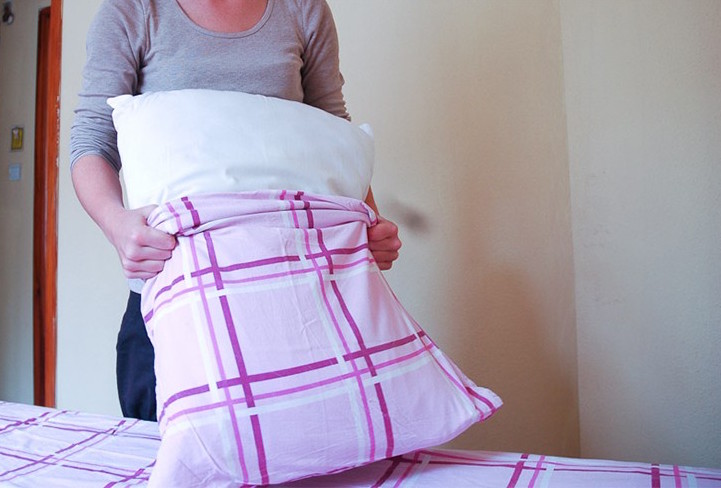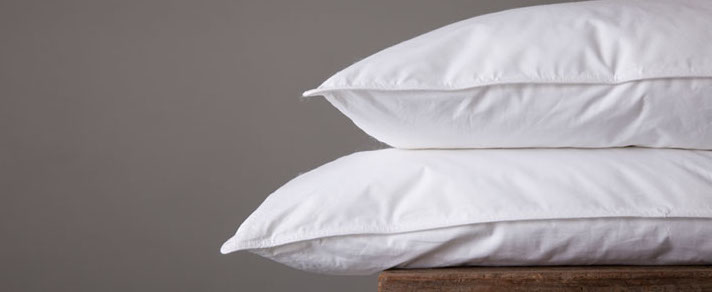At the end of each day, you’re always ready to flop into bed and lay your face on that soft, comfortable pillow of yours. Your pillow is like your oasis after a long day; something you look forward to during your mid-afternoon lull. But when was the last time you cleaned your pillow?
Pillows quickly become surprisingly dirty. They collect sweat, drool, makeup, hair products, dirt, dust, oil, mould, bacteria, and even little creatures such as lice and bed bugs.
After spending many nights tossing and turning on your pillow, these factors build up and create an unsanitary environment that you place your face on every night.
Pillows should be cleaned every three to six months. Washing your pillows periodically, instead of buying new ones, saves you money. Keeping them clean keeps you healthy, reduces allergens, and creates a sanitary place to lay your head at night.
A clean pillow promotes better, more restful sleep. You should also try to wash your pillowcases at least once a week. Most of the unwanted materials collect on the pillowcase, while only some of it seeps through to the pillow.
It takes longer for the materials to collect in a pillow, which is why you can go longer in between washings. Keeping your pillowcase clean will also help keep your pillow clean longer and lessen how often you should wash it.
If your pillows have care instructions on them, definitely follow what is advised. If not, there are general guidelines to follow, depending on the type of pillow you have. Be sure to be gentle with your pillows and treat them with care.
Cotton, Down, and Fiberfill
Cotton, down, and fiberfill pillows are great because they can be washed very quickly and with minimal effort. They’re generally safe to put into a washing machine.
It’s recommended to wash two pillows at a time while using a washing machine. Otherwise, the machine won’t stay balanced, and most modern machines will pause the wash cycle when this occurs.
It’s best if your machine does not have an agitator, but if it does, make sure to place the pillows in it vertically. Placing them vertically will make it more likely that they’ll get damaged by the agitator.
You’ll need:
- Washing machine
- Detergent
- (Optional) 1 cup hydrogen peroxide
- (Optional) ½ cup vinegar
- (Optional) Laundry booster
- (Optional) 2 tennis balls and 2 clean, white socks
Begin by removing the pillowcases. Do not clean your pillows without removing the pillowcases. Wash them separately from the pillows. If you do not remove the pillowcases or wash them separately, you run the risk of damaging your pillows. Colours can bleed onto the pillows, and they will not get thoroughly cleaned or rinsed.

Four Step Pillow Washing Guide
1. Wash
Add your pillows to your washing machine. Remember, try to wash two at once and, if you have an agitator, place them vertically in the machine. If you have a “bulky” or “large” cycle on your washer, use these options. Adjust the heat settings to hot or warm heat and the rinse settings to run an extra rinse of cold water. Add 1 cup of your detergent, then let your machine do its work.
If your pillows are yellowed and dingy, you can whiten them before washing them. After placing your pillows in the washing machine, add 1 cup of hydrogen peroxide and ½ cup of vinegar to the drum of the machine. Set the options to the “soak” setting and let your machine begin.
Once the soak cycle is complete, add your detergent and some laundry booster as normal. Adjust the settings to warm or hot water, with an extra rinse of cold water. Then let your machine run as normal.
2. Dry
Once your washing machine has finished its job, place your pillows in the dryer. For down pillows, adjust the settings to “air,” “fluff,” and “no heat.” If you attempt to dry your down pillows with heat, you risk damaging them or even starting a fire. For synthetic, cotton, and fiberfill pillows, adjust the settings to “low heat.”
These types of pillows are generally safer for heat but are still flammable and sensitive to higher temperature. A great way to add some extra fluff to your pillows is to put two tennis balls in two clean, white socks and add them to your dryer. This also helps them dry faster.
3. Check
Once your dryer has finished, check them for moisture. You can do so by squeezing and smelling them. If they’re not completely dry, replace them in the dryer and let them run for another cycle. Allowing moisture to stay trapped inside the pillows can lead to mould, which can cause them to smell and produce allergic reactions and is unsanitary.
4. Replace Pillowcases
Once you’ve ensured that your pillows are dry, complete your job by placing your clean pillowcases on them. Never put dirty pillowcases on clean pillows. This will undo all your work.
Memory Foam Pillows
Unfortunately, memory foam pillows cannot be placed in a washing machine. They take a little more effort to clean because washing machines are too rough on the delicate memory foam. You’ll need to hand wash these pillows to avoid damaging them.
They also cannot be placed in a dryer, so drying them will take extra time. Allow yourself at least 4 hours for your pillows to dry, but remember that it can take even longer.
Memory foam pillows are extremely dense so they hold water for a very long time. You do not want to replace pillowcases or sleep on pillow that still has moisture in them.
You’ll Need:
Large tub
Detergent
1. Remove pillowcases
Begin by removing the pillowcases or shams. If your memory foam pillow has a zip-on protective cover (most do), then remove this as well. The protective cover and pillowcases should be separately washed and can usually be washed in a washing machine.
2. Hand Wash
Begin by filling a large tub with enough warm water to cover your pillows. If your tub isn’t large enough for more than one pillow, you may need to wash only one at a time.
Add one tablespoon of detergent per pillow to the water and stir until you see some suds. Add your pillows to the water and push them down so they are fully submerged.
Use your hands as a washing machine and squeeze, massage, and gently agitate the pillows. Be very careful with your wet pillows because they can easily tear.
3. Rinse
Remove your pillows from the tub of water and rinse them under fresh water. While rinsing, squeeze the pillows again and again to remove all the suds.
Keep doing so until you no longer see suds. This will take quite a while, but it is essential to ensure that the pillows are free of detergent before drying. Leaving detergent in the pillows will make them break down quicker and damage them.
4. Dry
Never place your memory foam pillow in a dryer with heat, as it can quickly cause damage. The safest way to dry a memory foam pillow is to allow it to air dry on a flat surface.
Try placing it near an open window or in the sun to dry quicker. Drying your pillow is likely to take at least four hours, possibly more. Make sure to check it for moisture.
Do not place pillowcases on pillows that are still wet. This can cause mould and mildew to grow, which smells, is unsanitary, and causes allergy issues.
5. Replace Pillowcases
Once you’ve ensured that your pillows are dry, complete your job by placing your clean pillowcases and zippered pillow protector on them. Never place dirty pillowcases or protectors on clean pillows. This will undo all your work

.Conclusion
Washing your pillows is essential to them staying sanitary and helps them last longer. While you should wash your pillowcases at least once a week, wash your pillows at least every six months. If you get a contagious illness, wash your pillows as soon as you are no longer contagious.
Germs easily find their way to the pillows and can make your illness last longer or spread it to anyone else who lays on your pillow.
While washing your pillows should help them last longer, you should be replacing them at least every two and a half years. If your pillows are not memory foam, you can check them by folding them in half. If they do not spring back to normal, then it’s time to buy new pillows.
Once your pillows are clean, you can spray them with essential oils for added comfort. Lavender is the most recommended essential oil to promote relaxation and restful sleep. Only spray the pillows once per night so that they do not become too saturated with the oil.
Clean pillows promote more restful sleep and keep you healthier. Allergens tend to collect in pillows after some time, and you’re likely to notice a difference when sleeping on a clean pillow. Cleansing your pillows of all the natural oils, dirt, and sweat that seep into them helps them last longer and saves you money from buying new pillows prematurely.

